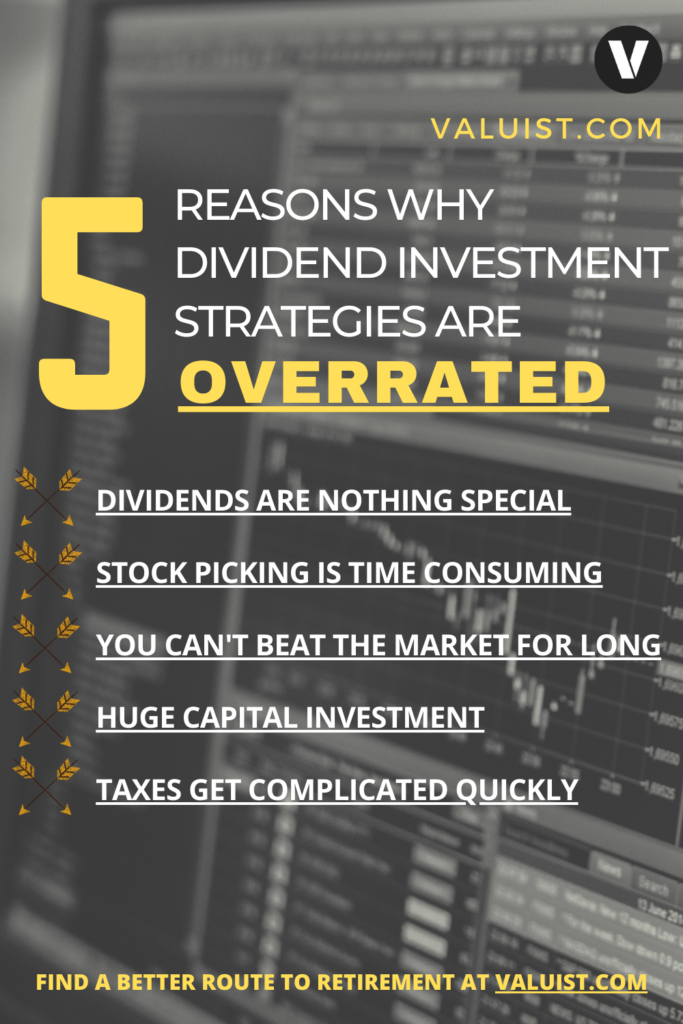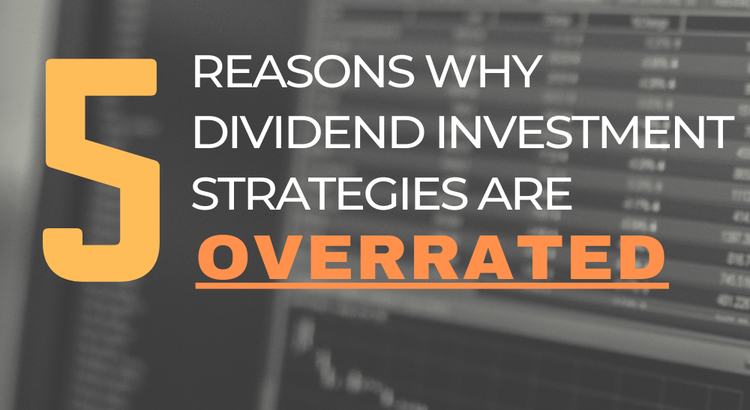Dividend investment strategies are too often touted as, ‘easy passive income.’ These strategies have been around forever but have become extremely popular on social media, among beginner investors. The appeal is apparently related to the side-income you can generate and the ability to, “live off of dividends”. Dividend investing ideology is perhaps even more popular as product to pitch to one’s “followers.” Actually, Ebook sales generally yield better returns than dividends do so I wouldn’t oppose that strategy if it’s not aiding to the spread of misinformation.
There’s nothing inherently wrong with dividends and I don’t deny that dividends are a powerful way to generate profit. They definitely factor into the Valuist investment strategy (automatically reinvested) and, can certainly help preserve wealth for retirees with substantial portfolios. However, dividends are nothing special and building an investment portfolio of dividend payers is not likely to replace your 9-to-5 anytime soon.
Here are 5 reasons why focusing too much on dividends is a mistake:
1. Dividends are simply profits that weren’t reinvested at the corporate level
When a public corporations earns profits they can choose to reinvest them into the business, for further growth, or issue them to shareholders as dividends. A dividend-paying stock/fund is not necessarily better than a non-payer, the underlying company has just chosen a different way to allocate profits. In fact, some of the best companies/investments don’t pay a dividend. Take a look at Warren Buffet’s, Berkshire Hathaway Class A Shares: BRKA has never split and famously, never paid a dividend. Because it has never split stock, BRKA routinely trades for hundreds of thousands of dollars per share.
2. You have to already be rich to earn significant income from dividends
At a 2% to 3.5% yield (if you’re lucky) earning any significant income from dividends requires a ridiculously high total investment. You would have to have around $200,000 invested in dividend stocks to earn just $500 a month from dividends at 2% yield and that’s before tax. Therefore, the idea that you can earn any meaningful side income, let alone replace your job is unrealistic for most investors in the acquisition phase.
3. Picking individual stocks assumes that you can actually beat the S&P 500 in the long run
Allocating a huge amount of your capital into individual stocks that pay dividends is, at best, unwise and at worst, disastrous to your retirement plan. The quickest way to lose money in the stock market is to deviate from the total stock market return. It has been demonstrated, again and again, that the average investor simply cannot do it. Even if you can beat the S&P 500 for a while, your chances of doing so for 20-30 years is near impossible. Even Warren Buffet admits that he can’t do it and he’s no slouch. Here’s a safer, less time consuming and more profitable way to invest.
4. Dividend Investing is a waste of time
In order to choose individual stocks with any degree of certainty you have to devote countless hours to learning technical analysis. Valuist covered stock analysis here but mostly to demonstrate how complicated and time consuming stock picking actually is.
Consider these options, which sounds better?
1. Spend countless hours researching, tracking, buying and selling stocks, then handle the complicated and sometimes expensive tax consequences of conducting numerous transactions a month.
Or
2. Invest in a single S&P 500 fund, or a total stock market fund, and earn better returns in 1/100th of the time.
5. Dividends complicate your taxes and typically cause you to owe more
Dividend returns are income in the eyes of the IRS and as such, are taxed according to some complicated rules. How much they are taxed depends on a number of factors, including whether the dividends you receive are qualified or nonqualified. If the stock has not been held for more than 60 days, during the 121-day period beginning 60 days before the ex-dividend date, then it will be taxed at your normal tax rate. Just understanding the “ex-dividend,” requires you to understand a slew of other information about how businesses issue stock.
Summary:
Can you build a great investment portfolio with all dividend-paying stocks? Sure! As long as the underlying corporations have solid fundamentals and you know how to analyze them, you can do very well with the strategy. However, it’s an overrated strategy because you can earn a better return with less risk, in less time with an index fund investment strategy. How would it feel when the market crashes and a company reduces or cancels its dividend? Or worse, if the company never regains value, leaving you with worthless stock for longer than you can afford to keep it? You just don’t have the same risk with an index fund because they are so broadly diversified.


